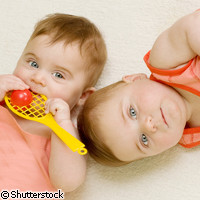Researchers assess assisted reproductive technology impact on twins
New research shows that twins born with the use of assisted reproductive technology (ART) have a higher chance of being admitted to neonatal intensive care and being hospitalised during their first three years of life compared with twins conceived spontaneously. The findings are published in the journal Human Reproduction. Past studies have already shown that ART twins are more vulnerable to problems like premature delivery and low birth weight than singletons (offspring born alone), and these problems are commonly linked to multiple births. To date, it has been unclear as to whether ART itself plays a key role in the problems sustained by these twins. British researchers, in cooperation with colleagues from Australia, evaluated perinatal outcomes and hospital admissions for twins born in Western Australian between 1994 and 2000, whether as a result of ART or spontaneous conception. ART twins are usually fraternal, while spontaneous twins can be either fraternal or identical. Fraternal twins are not identical and each has its own placenta and amniotic sac. Spontaneous fraternal twins occur when two ova are fertilised and identical twins occur when one fertilised ovum splits to make two embryos. There is an increased risk of complications or even death in cases of identical twins because they share a placenta. In order to compare like-for-like babies, the researchers in this study matched the ART twins with spontaneously conceived, non-identical twins of different sexes, calling them 'unlike sex spontaneously conceived twins (ULS SC twins)'. 'We found that twins conceived following ART treatment had a greater risk of adverse perinatal outcome, including preterm birth, low birth weight and death, compared with spontaneously conceived twins of unlike sex,' explained Ms Michèle Hansen of the Telethon Institute for Child Health Research in Western Australia. 'ART twins had more than double the risk of perinatal death compared to ULS SC twins, although the risk was similar to that of all SC twins, including identical twins,' the PhD student added. 'ART twins stayed longer in hospital than ULS SC twins at the time of their birth: an average of 12 days compared with 8 days. ART twins were four times more likely to be admitted to neo-natal intensive care than ULS SC twins, and were more likely to be admitted to hospital during the first three years of their life.' The researcher noted ART twins had twice the risk of succumbing to perinatal death than ULS SC twins, even though the risk was similar to that of all SC twins. 'After adjusting for confounding factors such as year of birth, maternal age, parity and so on, ART twins still had a nearly two-thirds higher risk of being admitted to neonatal intensive care, and a higher risk of being admitted to hospital in their first three years of life, although this was only statistically significant in their second year, when their risk was nearly two thirds higher,' she said. 'The underlying causes of parental infertility and/or components of the ART procedure may be increasing the risks of adverse outcome, and increased concern about children born after a long period of infertility may also be contributing to their increased risk of hospitalisation.' In another development, researchers from Sweden have found that children born after embryos were frozen and stored, before being thawed and transferred to the womb, are increasing in number. Based on latest data, 25% of ART babies worldwide are born using embryos that have undergone freezing or vitrification (a process similar to freezing that prevents the formation of ice crystals). 'Slow freezing of embryos has been used for 25 years and data concerning infant outcome seem reassuring with even higher birth weights and lower rates of preterm, and low birth weights than children born after fresh in vitro fertilisation or intracytoplasmic sperm injection (IVF/ICSI),' explained Dr Ulla-Britt Wennerholm, an obstetrician at the Institute for Clinical Sciences in Gothenburg, Sweden.
Countries
Australia, Sweden



